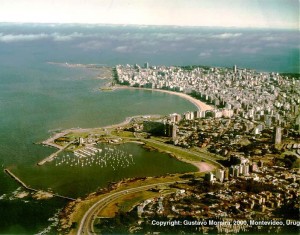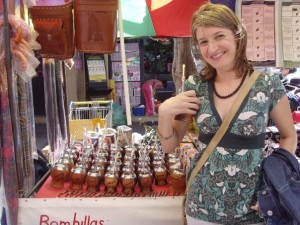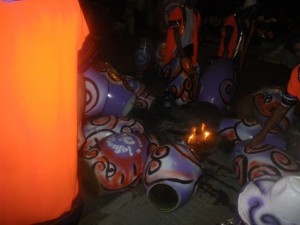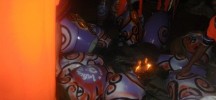
The first time I actually sailed into the bay of Montevideo was a very moving experience; discovering the lines of buildings of my own city from the sea like a casual traveler was something I hadn´t counted on. Montevideo looked beautiful, in spite of the typical landscape of a commercial port, with the container yards and run-down buildings all around. One of the most characteristic sights in this first vision of Montevideo is the hill of Cerro, which overlooks the bay. As the legend goes, it was upon seeing Cerro from the sea, that a Portuguese sailor cried out “Monte vide eu” (I saw a hill), and that is how the city got its somewhat musical name.
The port of Montevideo is the best natural port in the region, and for this reason it was coveted by every European conqueror that reached its shores, from the Spanish and the Portuguese to the Brits. The Old City is only a few steps away from the port, as it was the first settling place of the conquerers. This is extremely fortunate, since most tourist sites are located in this area.

In order to experience a taste of Uruguay, you only have to cross the street from the port´s gates into Mercado del Puerto. This restaurant court and open air market is located in and around an impressive building that once was a train station. Here you will find a series of grills (called “parrillas”), restaurants and bars where you can eat some of the best beef in the world, although my favorites to have there are the delicious pasta at “El Palenque”, and a dessert of strawberries with vinegar and pepper at “Don Tiburón”. Again, if you like your meat and your sausages, you have to try the chorizo (arguably the best in the world), and the gourmet stakes like Entrecot, for example.
But people don´t just go to Mercado del Puerto for the food; there is something else. The most popular drink at the Mercado is the famous Medio y Medio, a champagne-like bubbly mix that is sure to get you rather cheerful, but also sure to give you a bit of a headache in the long run. Nevertheless, it is tradition, it is inexpensive, and it´s unbelievably popular.
After washing down that asado (grilled beef in Uruguayan) with abundant Medio y Medio, you can do what Uruguayans do, and stroll down the rambla (one of the world´s longest boardwalks), take a nap in the sun, or have some mate (the typical Uruguayan infusion). If you are more into experiencing city life, you should walk towards Plaza Sarandí, the cultural center of the Old Town.

As you walk down those narrow streets, you will see the most beautiful historic buildings, although a large number of them will be in a poor condition. Strangely enough, this gives Montevideo part of its charm. It has the allure of a city of another time. You can see this when you pass the beautiful Plaza Zabala, a square surrounded by majestic, but, again, run-down buildings, which also has a view of the sea. There is this particular pink-coloured building I always fancied, and, oddly enough, last year I saw a building in Florence that looked just like it, only the Florentine construction was inhabited and in perfect shape, whereas the Uruguayan version is completely abandoned and falling apart.
Montevideo has always been a city of writers and musicians, and there are lots of art-related corners to discover in the Old Town. The CCE (Spanish Cultural Center) always has interesting exhibitions on display, and the Torres García Museum, on Sarandí street, pays tribute to Joaquín Torres García, a Uruguayan painter whose stature has been compaired to Picasso´s. The Café Brasilero coffee shop is a favorite with Uruguayan writers like the world famous Eduardo Galeano, and the small and cozy “La Ronda” bar is a popular meeting point for modern digital and visual artists, DJs and musicians. For a taste of traditional Uruguayan tango and a shot of a famous sweet drink called “uvita” (trust me, you must try it), you must also check out FUN FUN, with its live tango and Uruguayan music shows.
Speaking of music, there is something that anyone who visits Montevideo absolutely must experience: candombe. This is an African rhythm brought to the land by black slaves, which has come to be the source of everything that is original in Uruguayan jazz and popular music. In order to experience the power of the candombe drums, all you have to do is head down to the streets of the nearby neighbourhood of Barrio Sur on any Sunday afternoon, and mingle with the dozens of candombe drummers heating up their drums by the fire. Once the drums are warm enough, you have to follow them as they walk down the street playing candombe, in a procession that involves everyone, from female dancers at the front, to children, men, young and old people from the neighbourhood. The feeling of candombe is rather hard to describe, you just have to experience it for yourself.
If you are planning to spend the night (or several nights) in Montevideo, I recommend the cozy and stylish Plaza Fuerte hotel in the Old City and the Montevideo Sheraton for the best service, location, and the most magnificent views of the city.
Getting to Montevideo is easy from Buenos Aires and all other Latin American capitals, and direct airline tickets have become increasingly more available from many important airports around the world. International flights will take you to Montevideo´s fabulous brand new Carrasco airport, recently hailed as one of the top ten airports in the world.
Once you´ve had your asado, your mate and your candombe, you should definitely check out the views of the city from Cerro, drive along the miles and miles of rambla, walk down the beach, and enjoy the utterly relaxed Montevidean life-style. You shall encounter no traffic jams, no crowds and no hordes of tourists. The shopping and dining will be fabulous, and, last but not least, your dollars will still be worth something…
